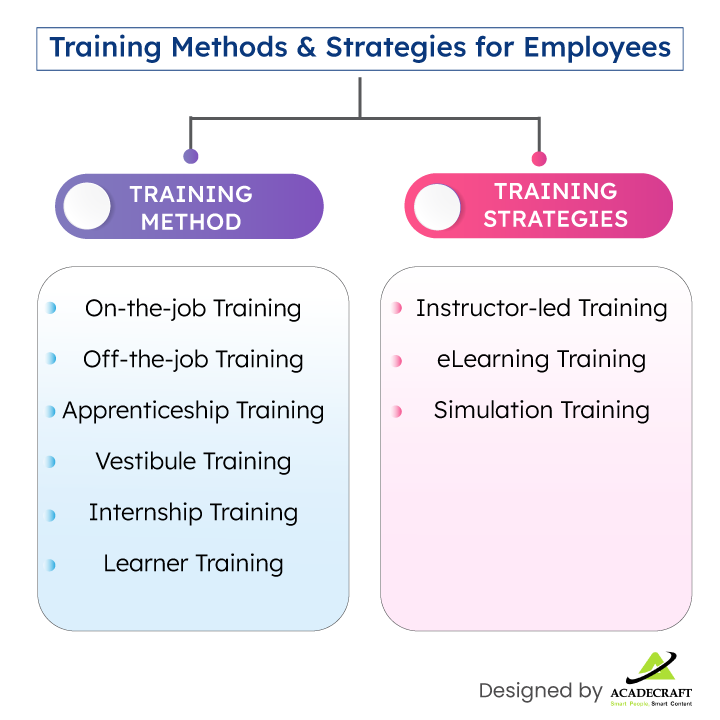
Employee training is essential to ensure that all the company employees have the knowledge and skills to do their jobs properly. The best employee training methods include on-the-job training, mentoring, eLearning and classroom instruction. By combining these methods, employers can ensure their employees are well-trained and fully equipped to succeed.
“In learning, you will teach, and in teaching, you will learn” ~ Phill Collins
For instance, a company could provide employees with an online training course to familiarize them with the company's policies and procedures while also providing mentorships and on-the-job training that will assist employees in gaining practical knowledge and skills.
Some of the best employee training methods include:
Each method has advantages and disadvantages, so choosing the one that best suits the needs is important.
Combining the various training methods and custom e-learning solutions helps employees gain theoretical knowledge from e-learning, practical skills from on-the-job training, and valuable guidance from mentorships, allowing them to perform their roles to the best of their abilities.
Learning is an ongoing process. There can be no other way to acquire knowledge than through learning and training. The journey of an employee must include employee training.
Employees who receive adequate training are ready to take on the demands and objectives of their jobs. We frequently assume that training is provided to new employees and wraps up after a certain period. The process of training, however, is ongoing and never-ending.
The company and employer must constantly train their staff to stay on top of new concepts, innovations, and technologies.
A recent report shows that in the US, 40% of employees leave their jobs within the first year because of poor training.
Organizations must invest in employee training and development to ensure their staff and businesses' success. Investing in training and development can ease staff turnover and will create a positive work environment. It also can help to increase productivity and create a more skilled workforce.

Employee training methods come in various varieties, and the variety grows with each passing year, which implies that each group, division, and business can select the training strategies that are most effective for their unique requirements.
So, what exactly is on the training menu?
Let us evaluate the different training methods for employees that are nowadays easily accessible.
On-the-job training is a great way to learn new skills and gain real-world experience. It involves learning from a supervisor or mentor in a real-world environment. This type of training is often the most effective since it allows for immediate feedback and practice of the skills being taught.
Off-the-job training is conducted in a controlled environment, such as a classroom or a training facility. It can also include online courses and webinars. This type of training is effective in providing an understanding of the theory.
Apprenticeship Training is a form of on-the-job training where a skilled worker, often called an apprentice, can learn a trade from a more experienced worker, often known as a mentor. The apprentice is usually paid for their work, and the mentor is usually given a fee for their time and guidance.
Vestibule Training is an apprenticeship program that combines classroom instruction with on-the-job training. The apprentice is mentored by a qualified professional, who supervises the apprentice and provides guidance and support. The mentor is responsible for teaching the apprentice the necessary skills.
Internship training is an important part of the apprenticeship, allowing the apprentice to gain hands-on experience in their chosen field. The mentor will provide the apprentice with the resources to learn the skills they are being taught and provide feedback and guidance as the apprentice works on their tasks.
The mentor will provide a structured learner training program to help the apprentice develop their skills and knowledge. This program will include specific tasks and activities designed to help the apprentice master the skills they are being taught.
To ensure that employees receive the most effective training, incorporating interactive methods, such as team-building activities, can be a powerful way to engage and motivate them.
An effective employee training strategy should focus on providing employees with the knowledge, skills and abilities needed to do their job effectively.
A good training program should incorporate both classroom instruction and hands-on practice. It should also include opportunities for employees to receive feedback and ask questions and opportunities for employees to practice their skills in a safe and supportive environment.
Instructor-led employee training involves having a knowledgeable and experienced instructor lead a group of employees through a training program.
The instructor provides a comprehensive overview of the material, offers explanations and demonstrations, and provides guidance and feedback when necessary.
Employees can benefit from the instructor's expertise by having an instructor lead the training, ensuring that the training is thorough and that their questions are answered.
eLearning can be an effective way for employees to receive training, as it is often more cost-effective and efficient than instructor-led training. Additionally, eLearning can be more engaging for employees, allowing them to interact directly with the learning materials.
For instance, a company may offer interactive video tutorials for employees to learn how to use a new software platform rather than having an instructor come in and lead a training session.
The video-based training enables employees to learn at their own pace and in their way. eLearning also allows companies to easily track employee progress and measure the effectiveness of the training.
The most common simulation training method uses a computer, gamification, augmented reality, or virtual reality device.
Regardless of the initial costs of developing that software or technology, simulation training may be necessary for employees working in potentially risky or high-stakes fields.
Simulator training is frequently used for pilots or medical professionals, but it can also be helpful for other workers.
This structure of employee training strategy is also extremely effective and dependable, allowing individuals to move forward consistently and at their own pace.
Selecting effective training methods for employees with various learning preferences and styles is not always simple. However, it will be much easier if the company chooses a training course to meet their needs.
The system should be tailored to the company's and employees' needs, provide interactive learning experiences, and use tools such as videos, presentations, and quizzes to engage trainees. This customized training approach will provide various learning experiences to engage different types of learners. It also allows employees to review material in their own time and at their own pace, which can help them retain the information better.
References:-
training methods
Share